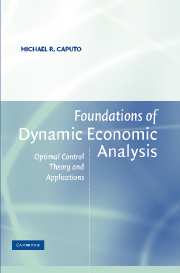Book contents
- Frontmatter
- Contents
- Foreword by Eugene Silberberg
- Preface
- 1 Essential Elements of Continuous Time Dynamic Optimization
- 2 Necessary Conditions for a Simplified Control Problem
- 3 Concavity and Sufficiency in Optimal Control Problems
- 4 The Maximum Principle and Economic Interpretations
- 5 Linear Optimal Control Problems
- 6 Necessary and Sufficient Conditions for a General Class of Control Problems
- 7 Necessary and Sufficient Conditions for Isoperimetric Problems
- 8 Economic Characterization of Reciprocal Isoperimetric Problems
- 9 The Dynamic Envelope Theorem and Economic Interpretations
- 10 The Dynamic Envelope Theorem and Transversality Conditions
- 11 Comparative Dynamics via Envelope Methods
- 12 Discounting, Current Values, and Time Consistency
- 13 Local Stability and Phase Portraits of Autonomous Differential Equations
- 14 Necessary and Sufficient Conditions for Infinite Horizon Control Problems
- 15 The Neoclassical Optimal Economic Growth Model
- 16 A Dynamic Limit Pricing Model of the Firm
- 17 The Adjustment Cost Model of the Firm
- 18 Qualitative Properties of Infinite Horizon Optimal Control Problems with One State Variable and One Control Variable
- 19 Dynamic Programming and the Hamilton-Jacobi-Bellman Equation
- 20 Intertemporal Duality in the Adjustment Cost Model of the Firm
- Index
- References
8 - Economic Characterization of Reciprocal Isoperimetric Problems
Published online by Cambridge University Press: 05 June 2012
- Frontmatter
- Contents
- Foreword by Eugene Silberberg
- Preface
- 1 Essential Elements of Continuous Time Dynamic Optimization
- 2 Necessary Conditions for a Simplified Control Problem
- 3 Concavity and Sufficiency in Optimal Control Problems
- 4 The Maximum Principle and Economic Interpretations
- 5 Linear Optimal Control Problems
- 6 Necessary and Sufficient Conditions for a General Class of Control Problems
- 7 Necessary and Sufficient Conditions for Isoperimetric Problems
- 8 Economic Characterization of Reciprocal Isoperimetric Problems
- 9 The Dynamic Envelope Theorem and Economic Interpretations
- 10 The Dynamic Envelope Theorem and Transversality Conditions
- 11 Comparative Dynamics via Envelope Methods
- 12 Discounting, Current Values, and Time Consistency
- 13 Local Stability and Phase Portraits of Autonomous Differential Equations
- 14 Necessary and Sufficient Conditions for Infinite Horizon Control Problems
- 15 The Neoclassical Optimal Economic Growth Model
- 16 A Dynamic Limit Pricing Model of the Firm
- 17 The Adjustment Cost Model of the Firm
- 18 Qualitative Properties of Infinite Horizon Optimal Control Problems with One State Variable and One Control Variable
- 19 Dynamic Programming and the Hamilton-Jacobi-Bellman Equation
- 20 Intertemporal Duality in the Adjustment Cost Model of the Firm
- Index
- References
Summary
Microeconomic theorists have learned to take advantage of the symmetry afforded by reciprocal pairs of static optimization problems. Recall that the adjective reciprocal signifies that the second (or reciprocal) optimization problem reverses the roles of the original (or primal) problem's objective function and constraint function, and substitutes the minimization hypothesis for the maximization hypothesis. The classical economic example of this occurs in the archetype pair of reciprocal (but not dual) consumer problems: utility maximization and expenditure minimization.
A powerful advantage in working with reciprocal pairs of optimization problems is that one has a choice of which problem to analyze in order to extract the economic information, for the information in one problem can always be used to extract the information in the other. For example, in the modern proof of the negative semidefiniteness of the Slutsky matrix one first establishes the negative semidefiniteness of the substitution matrix, which comprises the first partial derivatives of the Hicksian demand functions with respect to the prices, by invoking the concavity of the expenditure function and the envelope theorem. Then one uses this result along with the Slutsky equation to establish the negative semidefiniteness of the Slutsky matrix. Thus the modern proof of the negative semidefiniteness of the Slutsky matrix works off the reciprocal expenditure minimization problem rather than the primal utility maximization problem, even though the theorem to be proven pertains to the utility maximization problem's solution.
- Type
- Chapter
- Information
- Foundations of Dynamic Economic AnalysisOptimal Control Theory and Applications, pp. 211 - 230Publisher: Cambridge University PressPrint publication year: 2005



